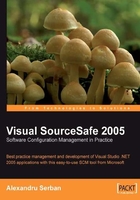
Chapter 2. The SourceSafe 2005 Architecture
Chapter 1 laid the theoretical foundation for the concepts that we are going to use through the rest of the book. From now, we will concentrate on the Microsoft Visual SourceSafe 2005 SCM tool.
Visual SourceSafe has a lot of history behind it. It is either loved for the fact that it is easy to use and integrates with many other Microsoft products, or hated probably because of the headaches given by using it improperly. It is designed to be used by individuals or by small and medium sized teams and not as an enterprise-level SCM tool (such as Visual Studio Team System). The SourceSafe 2005 edition addresses many of the past issues and adds new features, one the most notable being the support for internet connections when using Visual Studio .NET.
Any tool and technology is as good as the way you use it. Likewise you can drive a car better if you know how it works under the hood. In this chapter, we are going to take a look at the SourceSafe 2005 architecture, its core components, and how those components work together to do the job. We will look at the network configurations, the server components, the database, the client components, and the integration with Microsoft Visual Studio .NET 2005.
Visual SourceSafe 2005 has three main components:
- The Server applications and services
- The Database (repository)
- The Client applications
The following figure illustrates an overall look at these components. They will be described in more detail in the following sections.
